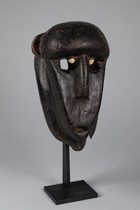Monkey mask "ngon" or "sulaw" · Mali, Bamana · ID: 3049636
Wolfgang Ketterer, Munich, 183. Auktion, Vol. I, 17 April 1993, Lot 25
Bernhard Jäger, Frankfurt a. M., Germany
Description
wood, rich black patina, oiled, snail shell, base
The monkey mask “sulaw” or “ngon” belongs to the “korè” society, which also owns the hyena mask “surukuw” and the lion mask “jaraw”.
These masks performed at the so-called “rain dances” that took place annually at the end of the dry season, at funeral ceremonies of important tribal members and when new initiates were admitted to the “korè” every seven years.
The masqueraders mimic the promiscuous, uncivilised and rowdy behaviour of monkeys, introducing humour and satire to celebrations. “Ngon” masks function as reminder of the animalistic qualities of man at its worst - and the need for a constant repression of that banality.
The object Monkey mask “ngon” or “sulaw” with the object ID 3049636 was last part of the auction 101st Auction at November 11, 2023 on Zemanek-Münster Auction house. The object with the lot number 114 achieved a sales price of EUR 1,100.
You can find more Masks and other popular object types on our related topic pages. You may also be interested in our page on African art.
Comparing literature
Colleyn, Jean Paul (Hg.), Bamana, Zürich 2001, p. 97 ff. Davis, Charles B., The Animal Motif in Bamana Art, New Orleans o. J., p. 38 f.
Publications
AHDRC: 0079400





